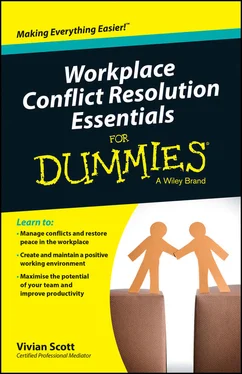Chapter 2
Understanding What People Bring to Conflict
In This Chapter
Reviewing communication
Understanding the individual’s perspective
 Shedding light on emotions
Shedding light on emotions
Addressing common responses to conflict
E ach person in your workplace is a complex system of past experiences, beliefs, values, opinions and emotions. Each has different ways of communicating, processing the things around him or her, and handling conflict.
This chapter helps you gain a better insight into the people on your team – why they see things the way they do, why they react to different people in different ways, and how their emotions can complicate the whole situation. You can start to understand how your colleagues’ personal beliefs and attributes contribute to the team dynamic and sometimes contribute to conflict (which is normal, natural and inevitable, by the way) so that you can build better working relationships and a more productive working environment. You’ll see the broader foundation of conflict and be more prepared to proactively reduce and perhaps prevent it.
Rediscovering Communication
Good communication is the hallmark of a productive working relationship. Easier said than done, right? Even when you believe you’re being crystal clear, it’s possible that the other person doesn’t understand what you’re really trying to say. This happens for a variety of reasons, including differences in goals, misunderstandings with language, ambiguous body language and misinterpretations of tone of voice.
Changing the goal of communication
In conflict, goals for communication often turn destructive. If someone in your group enters into a conversation for the sole purpose of proving that she’s right, making the other person feel bad or establishing that the other person is an incompetent fool, the conflict is likely to get worse.
Reaching agreement is commonly thought of as the goal of communication, but this misconception is often one of the most unnecessary causes of conflicts. Instead, focus on creating understanding – and understanding doesn’t mean agreeing. It isn’t necessary for the two people in conflict to see eye to eye and walk away holding hands, but it’s helpful if they can talk to each other respectfully, feel heard by each other, and gain a greater understanding of the situation and the other person.
The old cliché ‘agree to disagree’ may be coming to mind. In a way, this saying is both accurate and inaccurate. The two people in the conflict may end their discussion on this note, and that’s fine as long as they both put forth a 100-per-cent effort to listen and understand each other. Unfortunately, most people use this saying as a quick way to end a conversation. They’re tired of trying to talk with the other person so they agree to disagree as a polite way of brushing off the other person. That’s not what striving for understanding is about.
Ultimately, if two people have a real and productive conversation where they both listen and feel heard, they’ll probably find more in common with each other and find more points to agree on. Changing the goal of communication is a new way to think about it and, even if you’re not directly involved in the conflict, if you shift your thinking, you’ll have a head start on working with employees to solve their issues.
Choosing words carefully: The importance of language
One of the most common contributors to miscommunication is language. The words you use can lead to misinterpretations and negative reactions, either because you choose words that don’t accurately express what you’re trying to say or you use words that the listener finds inappropriate or insulting. In some cases, the miscommunication is simply a matter of semantics (the meaning and interpretation of words).
Making sure you’re on the same page
Words are slippery things, and the same word can have different meanings for different people. The best ways to avoid misunderstandings are to be specific and to get creative. Take more time in a conversation, choose your words carefully and ask clarifying questions. If you suspect semantics are getting in the way, take a moment to define the word in question. State what that word means to you, and ask the other person what it means to her. This clarification could shed light on the disagreement.
When starting a conversation, try to avoid misunderstandings by giving thought to what information you’re trying to relay or gather, and then formulate a statement or question that meets that goal. For example, asking a colleague to respect you isn’t as clear as asking her to respect you by not playing practical jokes on you. Telling your boss that you want time off isn’t as clear as requesting leave for the week of 1 January.
 You can also get creative and find other ways to get your message across. If words are keeping people from a shared understanding, try a different method of communication. Visual aids like photos, maps, charts and diagrams can be tremendously helpful. In some situations you may find that a demonstration or tutorial clarifies a point.
You can also get creative and find other ways to get your message across. If words are keeping people from a shared understanding, try a different method of communication. Visual aids like photos, maps, charts and diagrams can be tremendously helpful. In some situations you may find that a demonstration or tutorial clarifies a point.
Being precise
Using words or phrases that are vague or too open to interpretation can cause problems. If you’re using one of the following words or phrases, consider whether you can be more precise:
 Sometimes
Sometimes
 In a timely manner
In a timely manner
 As needed
As needed
 To my satisfaction
To my satisfaction
 A few
A few
 Several
Several
 Often
Often
 Frequently
Frequently
 When you get a chance
When you get a chance
Be proactive and use specifics whenever possible. If you have an expectation that the sales receipts need to be turned in ‘at the end of the day’, say that what you really mean is ‘by 5.30 pm each and every day’. Being specific avoids confusion and uncertainty.
Avoiding inflammatory language
Using the wrong language can make a good situation bad or a bad situation worse. By choosing inflammatory words to get a message across, you can easily sound insulting, insensitive, hurtful or just plain mean. Some inflammatory words, such as name-calling, are very obvious. Calling someone stupid, lazy or incompetent can get you in trouble, not only with your team or manager but also with the human resources department!
Beyond the obvious, some words are just easier for a listener to hear. For example, if an employee or colleague approaches you and says, ‘I hate my job’, you’ll probably have a negative reaction. If the same employee instead says, ‘I’m dissatisfied with my job’, your reaction would be quite different. Some words have a negative impact, and the trick to getting a more positive reaction from listeners is to find more neutral words that they won’t find offensive. I provide hints on neutralising language in Chapter 7 Конец ознакомительного фрагмента. Текст предоставлен ООО «ЛитРес». Прочитайте эту книгу целиком, купив полную легальную версию на ЛитРес. Безопасно оплатить книгу можно банковской картой Visa, MasterCard, Maestro, со счета мобильного телефона, с платежного терминала, в салоне МТС или Связной, через PayPal, WebMoney, Яндекс.Деньги, QIWI Кошелек, бонусными картами или другим удобным Вам способом.
.
Читать дальше

 Shedding light on emotions
Shedding light on emotions You can also get creative and find other ways to get your message across. If words are keeping people from a shared understanding, try a different method of communication. Visual aids like photos, maps, charts and diagrams can be tremendously helpful. In some situations you may find that a demonstration or tutorial clarifies a point.
You can also get creative and find other ways to get your message across. If words are keeping people from a shared understanding, try a different method of communication. Visual aids like photos, maps, charts and diagrams can be tremendously helpful. In some situations you may find that a demonstration or tutorial clarifies a point. Sometimes
Sometimes In a timely manner
In a timely manner As needed
As needed To my satisfaction
To my satisfaction A few
A few Several
Several Often
Often Frequently
Frequently When you get a chance
When you get a chance










